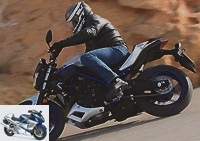Yamaha MT-03 test: city roadster

Building on the success of its Master of Torque (MT) range, Yamaha is further expanding its roadster offering with the attractive MT-03, directly derived from the sporty R3. Versatile, it is suitable for young A2 drivers as well as more experienced bikers. Test.
The MT-03 makes its comeback !
Formerly driven by a single cylinder 660 cc of 45 horsepower, the late MT-03 is reborn from its ashes after having recently disappeared from the Yamaha range. The name remains, but this new version has nothing to do with its ancestor released 10 years earlier (read our)…
The MT-03 is in fact based on the youngster, from whom it takes, among other things, the 321cc twin-cylinder, the robust 35mm tubular steel frame and most of the components..
This chassis is made up of 35 mm tubes and is associated with a long (573 mm) asymmetrical swingarm, also in steel, on which the Monocross rear suspension is directly anchored with adjustable shock absorber in spring preload..
Alloy wheels with five split-spoke spokes, exhaust silencer, 14-liter fuel tank, non-disconnectable ABS braking system, two-seater two-level saddle, position of the footrests: all these features discovered on the R3 are listed below. ‘identical on the MT-03. A platform sharing already operated by Yamaha in its "MT" range with the MT-125, modeled on the sporty YZF-R125.
However, the MT-03 asserts its difference by stripping the R3 of its almost full fairing. It adopts a flat handlebar, a minimalist headlight with LED position lights, new mirrors and a small engine spoiler to hide the lower part of its exhaust pipes. It’s not much on paper, but it’s enough to transform the bike !
The dashboard is strictly the same, with its large tachometer incorporating digital fuel and water temperature gauge and its digital dial comprising tachometer, gear indicator engaged and other useful information (clock, remaining range, average consumption and instantaneous, kilometer recorders and daily trips). Even the shift light indicating the approach of over-revs is retained.
On the engine side, the vertical twin with double camshaft is strictly identical: the case-hardened connecting rods, the forged aluminum pistons and the cylinders "DiASil"aluminum with high silicone content (20%) have not changed at all. These cylinders are also slightly offset – exactly 7 mm – to reduce friction and oil consumption.
The crankshaft, with a simple balancing arm, is for its part set at 180 ° for performance and ease of use. As on the R3, this engine produces 42 horsepower at 10,750 rpm, for a torque of 29.6 Nm at 9,000 rpm.
Related articles
-
All Tests – Test Yamaha MT-03: city roadster – Technical and sales sheet MT-03 2016
Yamaha MT-03 test: city roadster Building on the success of its Master of Torque (MT) range, Yamaha is further expanding its roadster offering with the…
-
All Tests – Test Yamaha MT-03: city roadster – Yamaha MT-03: suburban toy
Yamaha MT-03 test: city roadster Building on the success of its Master of Torque (MT) range, Yamaha is further expanding its roadster offering with the…
-
All Tests – 2013 FZ8 Test: Spring for the Yamaha Roadster! – Bosses galore
2013 FZ8 test: spring for the Yamaha roadster ! On the best selling motorcycle segment in France, the mid-capacity roadster, the Yamaha FZ8 made a…
-
2013 FZ8 test: spring for the Yamaha roadster ! On the best selling motorcycle segment in France, the medium-capacity roadster, the Yamaha FZ8 made a…
-
All Tests – Test Yamaha MT-03: city roadster – Roadster search, intuitive and easy
Yamaha MT-03 test: city roadster Building on the success of its Master of Torque (MT) range, Yamaha is further expanding its roadster offering with the…
-
All Tests – MT-09 Test: Yamaha’s future road’star ‘! – A versatile roadster
MT-09 test: Yamaha’s future road star ! Symbol of a new era to come, Yamaha unveiled a new three-cylinder almost a year ago. The first motorcycle to be…
-
All Tests – 2013 FZ8 Test: Spring for the Yamaha Roadster! – And on the track?
2013 FZ8 test: spring for the Yamaha roadster ! On the best selling motorcycle segment in France, the medium-capacity roadster, the Yamaha FZ8 made a…
-
Roadster – Yamaha XSR 900 test: the MT-09 puts 3-legs in the retro – Yamaha in the retro
Yamaha XSR 900 test: the MT-09 puts 3-legs in the retro After the XSR700 imagined in collaboration with Japanese designer Shinya Kimura on the basis of…
-
Triumph Rocket III Roadster and Yamaha Vmax in the test
Triumph Rocket III Roadster and Yamaha Vmax in the test Motorcycles with a large displacement in a comparison test Triumph Rocket III Roadster and Yamaha…
-
All Tests – Skyliner S and Majesty S Test: more beautiful the city – His Majesty’s return to Yamaha
Skyliner S and Majesty S test: more beautiful the city This summer, MBK and Yamaha are simultaneously launching their new urban scooters: the Skyliner S…